
Moray is one of the 32 local government council areas of Scotland. It lies in the north-east of the country, with a coastline on the Moray Firth, and borders the council areas of Aberdeenshire and Highland.
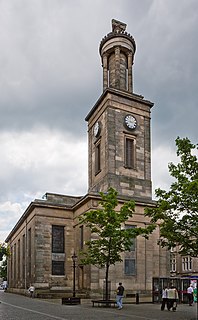
Elgin is a town and formerly a Royal Burgh in Moray, Scotland. It is the administrative and commercial centre for Moray. The town originated to the south of the River Lossie on the higher ground above the floodplain where the town of Birnie is. There, the church of Birnie Kirk was built in 1140 and serves the community to this day. Elgin is first documented in the Cartulary of Moray in 1190 AD. It was created a royal burgh in the 12th century by King David I of Scotland, and by that time had a castle on top of the present-day Lady Hill to the west of the town. The origin of the name Elgin is likely to be Celtic. It may derive from 'Aille' literally signifying beauty, but in topography a beautiful place or valley. Another possibility is 'ealg', meaning both 'Ireland' and 'worthy'. The termination 'gin' or 'in' are Celtic endings signifying little or diminutive forms, hence Elgin could mean beautiful place, worthy place or little Ireland.

Dufftown is a burgh in Moray, Scotland. While the town is part of the historic Mortlach parish, the town was established and laid out in the early 19th century as part of a planned new town settlement. The town has several listed 19th century buildings and serves as a regional centre for agriculture, tourism and services. The town is well known for its whisky based economy, as it produces more whisky than any other town in Scotland and is home to several existing and former distilleries.

Moray or Morayshire, called Elginshire until 1919, is a historic county, registration county and lieutenancy area of Scotland, bordering Nairnshire to the west, Inverness-shire to the south, and Banffshire to the east. It was a local government county, with Elgin the county town, until 1975. The county was officially called Elginshire, sharing the name of the Elginshire parliamentary constituency, so named since 1708.

Moray eels, or Muraenidae, are a family of eels whose members are found worldwide. There are approximately 200 species in 15 genera which are almost exclusively marine, but several species are regularly seen in brackish water, and a few are found in fresh water.
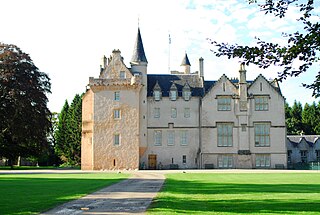
Brodie Castle is a well-preserved Z plan castle located about 3+1⁄2 miles west of Forres, in Moray, Scotland. The castle is a Category A listed building and the grounds are included in the Inventory of Gardens and Designed Landscapes in Scotland.

Moray is a county constituency of the House of Commons of the Parliament of the United Kingdom. It elects one Member of Parliament (MP) by the first past the post system of election.

Kinloss Abbey is a Cistercian abbey at Kinloss in the county of Moray, Scotland.
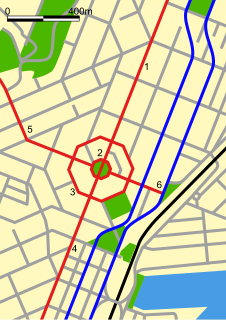
Moray Place is an octagonal street which surrounds the city centre of Dunedin, Otago, New Zealand. The street is intersected by Stuart Street, Princes Street and George Street. Like many streets in Dunedin, it is named for a street in the Scottish capital Edinburgh.

Spynie Palace, also known as Spynie Castle, was the fortified seat of the Bishops of Moray for about 500 years in Spynie, Moray, Scotland. The founding of the palace dates back to the late 12th century. It is situated about 500 m from the location of the first officially settled Cathedral Church of the Diocese of Moray, Holy Trinity Church in present-day Spynie Churchyard. For most of its occupied history, the castle was not described as a palace — this term first appeared in the Registry of Moray in a writ of 1524.

Gymnothorax is a genus of fish in the family Muraenidae found in Atlantic, Indian and Pacific Ocean. With more than 120 species, it the most speciose genus of moray eels.
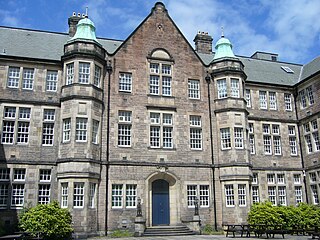
The Moray House School of Education and Sport is a school within the College of Arts, Humanities and Social Science at the University of Edinburgh. It is based in historic buildings on the Holyrood Campus, located between the Canongate and Holyrood Road.

Stuart Street is one of the main streets of Dunedin, New Zealand. As with many of Dunedin's streets, it is named after a main street in Edinburgh, Scotland.

The Cabrach is an estate and largely depopulated rural community in Moray, Scotland. The meaning of the name has been much disputed. Traditionally it is held to mean "timber moss", though this has no recognisable counterpart in Scottish Gaelic, and Alexander Smith (1875) suggests no Gaelic meaning can be assigned. Iain Mac an Tàilleir (2003) gives a meaning "antler place", whilst Ainmean-Àite na h-Alba, the national advisory partnership for Gaelic place-names in Scotland, suggests "the place of the trees".

Portgordon, or sometimes Port Gordon, is a village in Moray, Scotland, 2 km south-west of Buckie. It was established in 1797 by Alexander Gordon, 4th Duke of Gordon as a fishing village. It had a population of 844 at the time of the 2011 census. Currently the Portgordon Community Harbour Group is trying to regenerate the harbour and open a marina.

The Beatrice Offshore Wind Farm now known as Beatrice Offshore Windfarm Ltd (BOWL) project, is a wind farm close to the Beatrice oil field in the Moray Firth, part of the North Sea 13 km off the north east coast of Scotland.

Donibristle was a house and estate in Fife, Scotland, on the coast of the Firth of Forth. Only the wings of the house remain, within the modern settlement of Dalgety Bay. They are now protected as a category A listed building. Donibristle was the scene of the killing of James Stewart, 2nd Earl of Moray, in 1592, which is remembered in the ballad "The Bonnie Earl O' Moray".
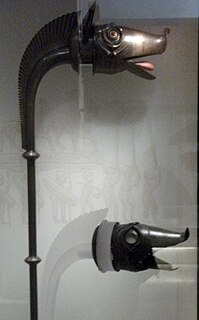
Deskford is a parish and a small settlement in Moray, Scotland, formerly in Banffshire.
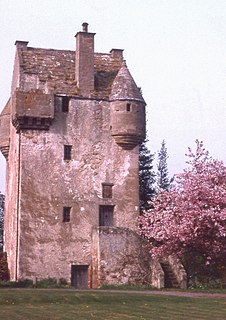
Coxton Tower is a late sixteenth-century tower house in Moray, Scotland. Heavily fortified, it was built around 1590, with substantive repairs in 1635 and 1645, but its design is reminiscent of much older buildings. It has not been occupied since around 1867 except to house Canadian soldiers during the Second World War, but was renovated in 2001 to help protect the fabric of the structure, which is designated a Category A listed building.

















